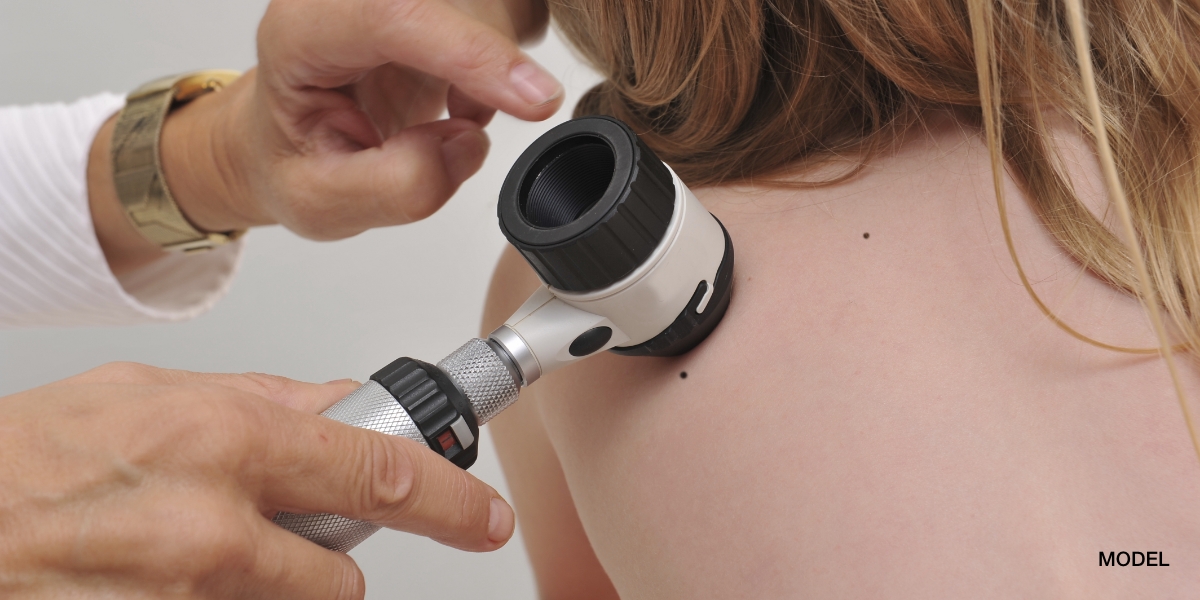Skin cancer can take many forms and can occur anywhere on the skin and can even occur underneath the nails, so I always recommend a complete skin exam at a patient’s first visit and then at least annually by myself or another board certified dermatologist. I begin each exam by inquiring about any new or changing skin lesions. Typically, a skin cancer exhibits change either in size, shape, color or it has become symptomatic and is bleeding or itching. I inspect these changing moles or lesions first with a dermatoscope, which is a hand held device that allows me to inspect the lesion’s architectural pattern by examining just below the skin surface. Once I have examined all of the lesions worrisome to the patient, I began a systematic scan of the entire skin beginning with the hands. I closely inspect the nail plate as melanoma can occur in the nail matrix and typically appears as a vertical black line that traverses the nail from the cuticle to the end of the nail plate. It appears as if a Sharpie was used to draw a black line on the hand. The toenails are not exempt from skin cancer, as melanoma can occur on the feet even though these are sun protected areas. Thus, a thorough exam of the toe webs and soles of the feet is prudent. 90% of all skin cancers occur on the face due to sun exposure so this area is closely examined. The nose and ears are the most common places on the face for skin cancer as they get a direct assault from the sun’s UV rays. Typically, the ears are not covered with baseball caps and many patients forget to use sunscreen on their ears. Although, the scalp is covered with hair in most patients, skin cancer can be found here as well. Many of my patients have been referred to my office by their hairdressers/barbers who have detected a skin cancer while cutting their hair and saved their lives. The back is one of the most common areas for abnormal moles and melanomas so a close inspection of all pigmented lesions on the back is essential. Many patients forget to apply sunscreen to the V of their neck which gets direct sun exposure as most shirts are cut in the shape of a V leaving this area exposed. In my practice, I always offer a complete skin exam at each visit even when a patient is presenting with a rash since early detection is the key to increased survival, decreased morbidity and a better cosmetic outcome when removing skin cancer.
July 17, 2010

Medically reviewed by Anthony J. Perri, M.D.
You May Also Like



Request a Consultation (Sidebar)
Recent Posts
Categories
- Uncategorized (512)
Tags
acne (6)
acne treatment (3)
acne vulgaris (2)
basal cell carcinoma (2)
biopsy (3)
cold urticaria (1)
common skin conditions (11)
dermatologist (15)
dermatology (7)
dr. perri (8)
dry skin (1)
eczema (2)
filiform (1)
health (3)
Herpes (1)
herpessimplex (1)
hives (2)
indentification (1)
keratosis pilaris (1)
Lichen Planopilaris (1)
melanoma (2)
moles (3)
periungual (1)
perri dermatology (10)
prevention (2)
rashes (2)
rosacea (3)
rosacea therapy (2)
skin cancer (6)
skin cancer screening (5)
skin care (2)
skin checks (8)
skin condition (6)
skin conditions (8)
skin damage (2)
skin exam (8)
summertime (3)
sunburn (3)
sunburns (2)
Sunprotection (1)
sunscreen (2)
virus (1)
warts (2)
why perri dermatology (3)
woodlands dermatologist (6)
